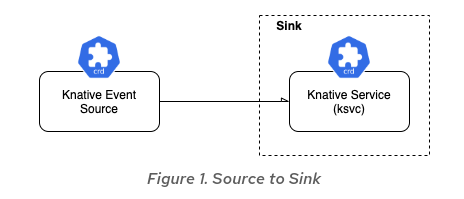1. Introduction
Several ER-Demo services are serverless enabled using the capabilities of Knative on OpenShift.
Knative extends facilities in Openshift and Kubernetes to provide a scalable environment for deploying services that scale up and down based on demand. It also provides an eventing mechanism to provide decoupled messaging to applications running inside an Openshift or Kubernetes cluster.
Knative consists of the following components:
-
Serving - Request-driven compute that can scale to zero Knative Serving is ideal for running application services inside OpenShift by providing a more simplified deployment syntax with automated scale-to-zero and scale-out based on HTTP load . The Knative platform will manage your service’s deployments, revisions, networking and scaling. Knative Serving exposes your service via an HTTP URL. As the Knative Serving Service has the built in ability to automatically scale down to zero when not in use, it is apt to call it as “serverless service”. Knative Serving is mostly adapted for stateless applications with minimal or no dependencies on other systems.
-
Eventing - Management and delivery of events to and from Knative services Knative Eventing is designed to decouple event sources and event consumers. Knative Eventing services are loosely coupled and can be developed and deployed independently. Event producers and event consumers are independent. Any producer (or source), can generate events before there are active event consumers that are listening. Any event consumer can express interest in an event or class of events, before there are producers that are creating those events. Cross-service interoperability is provided by adhering to the CloudEvents specification that is developed by the Cloud Native Computing Foundation Serverless working Group.
In the Emergency Response Demo application, both Knative Serving and Knative Eventing are installed by default. The list of Knative enabled services can be seen as per the following:
$ OCP_USERNAME=user1 # CHANGE ME IF NEEDED
$ oc get kservice -n $OCP_USERNAME-er-demo
NAME URL LATESTCREATED LATESTREADY READY REASON
datawarehouse http://datawarehouse-user1-er-demo.apps.ratwater.xyz datawarehouse-8sfmk False RevisionMissing
find-service http://find-service-user1-er-demo.apps.ratwater.xyz find-service-xff7s find-service-xff7s True
kafdrop http://kafdrop-user1-er-demo.apps.ratwater.xyz kafdrop-wn479 kafdrop-wn479 True
Details pertaining to each type of Knative capability are found in the following sections:
2. Knative Serving:
This section provides details how to verify the installation of Knative Serving functionality in ER-Demo.
-
Verify the successful installation of the knative operator in the openshift-operators namespace:
$oc get subscription serverless-operator -n openshift-operators NAMESPACE NAME PACKAGE SOURCE CHANNEL openshift-operators serverless-operator serverless-operator redhat-operators 4.4 -
Verify the successful installation of Knative Serving:
$ oc get knativeserving.operator.knative.dev/knative-serving \ -n knative-serving \ --template='' DependenciesInstalled=True DeploymentsAvailable=True InstallSucceeded=True Ready=True -
View scale-out capability of knative enabled kafdrop service in ER-Demo
3.1 Tail container orchestration events in the er-demo namespace
$oc get events -w -n $OCP_USERNAME-er-demoKeep this terminal window open.3.2 Navigate a browser tab to the output of the following command:
echo -en "\n\n$(oc get kservice kafdrop --template='' -n $OCP_USERNAME-er-demo)\n\n"3.3 Notice container orchestration events such as the following as a kafkdrop service is spun up from zero:
0s Normal ScalingReplicaSet deployment/kafdrop-wn479-deployment Scaled up replica set kafdrop-wn479-deployment-687449d4b6 to 1 0s Normal SuccessfulCreate replicaset/kafdrop-wn479-deployment-687449d4b6 Created pod: kafdrop-wn479-deployment-687449d4b6-p7btj 0s Normal Scheduled pod/kafdrop-wn479-deployment-687449d4b6-p7btj Successfully assigned user1-er-demo/kafdrop-wn479-deployment-687449d4b6-p7btj to worker-1.ratwater.xyz 0s Normal AddedInterface pod/kafdrop-wn479-deployment-687449d4b6-p7btj Add eth0 [10.128.2.125/23] 0s Normal Pulled pod/kafdrop-wn479-deployment-687449d4b6-p7btj Container image "index.docker.io/obsidiandynamics/kafdrop@sha256:b7ba8577ce395b1975b0ed98bb53cb6b13e7d32d5442188da1ce41c0838d1ce9" already present on machine 0s Normal Created pod/kafdrop-wn479-deployment-687449d4b6-p7btj Created container user-container 0s Normal Started pod/kafdrop-wn479-deployment-687449d4b6-p7btj Started container user-container 0s Normal Pulled pod/kafdrop-wn479-deployment-687449d4b6-p7btj Container image "registry.redhat.io/openshift-serverless-1/serving-queue-rhel8@sha256:8d45d901a58ec5da58e97b5e0d38ce22a9318837a13926ef6c21bb5b81f0bcb0" already present on machineIf interested, the following write-up and webinar details the internals of the Knative Serving auto-scaling implementation.
3. Knative Eventing:
The datawarehouse service of the ER-Demo is Knative Eventing enabled and implemented using a Source to Sink approach. The Knative tutorial mentions the following about the Source to Sink usage pattern:
Source to Sink provides the simplest getting started experience with Knative Eventing. It provides single Sink — that is, event receiving service –, with no queuing, backpressure, and filtering. The Source to Service does not support replies, which means the response from the Sink service is ignored. The responsibility of the Event Source is just to deliver the message without waiting for the response from the Sink, hence it is comparable to the fire and forget messaging pattern.

This section provides details how to verify the installation of Knative Eventing functionality in ER-Demo.
- Verify the successful installation of Knative Eventing:
$ oc get knativeeventing.operator.knative.dev/knative-eventing \ -n knative-eventing \ --template='' InstallSucceeded=True Ready=True - Verify the various types of Knative eventing sources:
$ oc api-resources --api-group='sources.knative.dev' NAME APIGROUP NAMESPACED KIND apiserversources sources.knative.dev true ApiServerSource kafkasources sources.knative.dev true KafkaSource pingsources sources.knative.dev true PingSource sinkbindings sources.knative.dev true SinkBinding - Verify the datawarehouse-source (used by the Knative Eventing enabled datawarehouse service):
$ oc get kafkasources -n $OCP_USERNAME-er-demo NAME TOPICS BOOTSTRAPSERVERS READY REASON AGE datawarehouse-source [topic-incident-command] [kafka-cluster-kafka-bootstrap.user1-er-demo.svc:9092] False NotFound 4d3h - Verify that the datawarehouse-service is configured to scale-to-1:
$ oc get kservice datawarehouse -o template --template map[autoscaling.knative.dev/minScale:1]